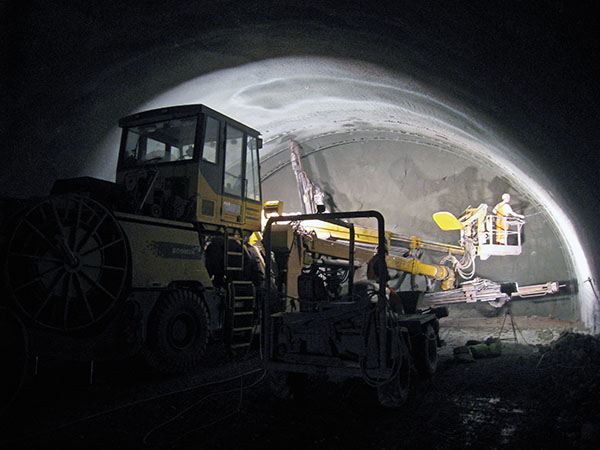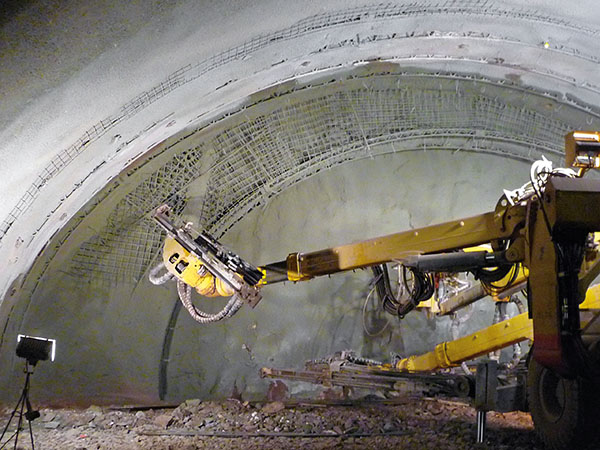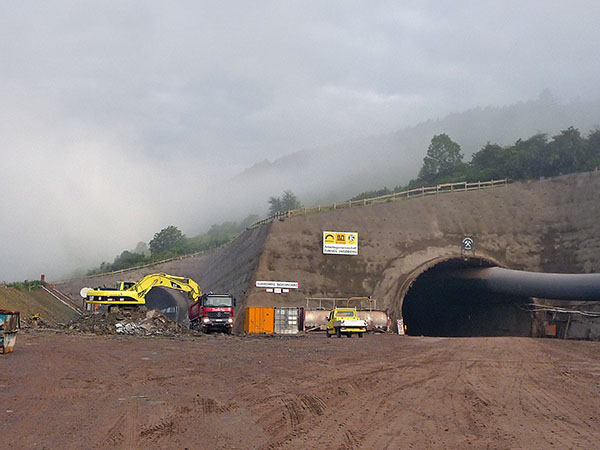


The Jagdberg Tunnel: ALWAG Systems stabilize East-West Motorway Axis
The A4 motorway links central Germany with Poland and is one of the most important East-West axes in Europe. The section between Magdala and Jena-Goeschwitz is no longer able to accommodate the current traffic volume of more than 50,000 vehicles per day. Due to many steep grades and a large number of sharp curves along the motorway, traffic flow is considerably obstructed by slow-moving trucks.
In May 2008, construction began on an 11.8km long section that will be widened to six lanes. In order to protect the ecologically sensitive Leutra valley, the section was designed to include a 3km tunnel. The Jagdberg Tunnel consists of two parallel tubes with three lanes each. With a maximum overburden of approx. 134m, the tubes have an axis-center distance of approx. 35m and cross sections of 125-155m². The 3,074m long northern tube was excavated using mining techniques over a length of 3,042m. 10m of the tunnel tube at the eastern portal and 22m at the western portal were built using the open cut tunneling method. The 3,070m long southern tube was excavated using mining techniques over a length of 2,930m. 10m at the eastern portal and 130m at the western portal were built using the open cut method. The tunnels were driven by drilling and blasting in accordance with the New Austrian Tunneling Method (NATM). Both tubes were driven in opposite directions with an advancing crown with advance rates of up to 9m a day. The driven sections were immediately stabilized using anchors and steel reinforcement encased in gunite. Final reinforcement was provided by a 40-50cm thick inner concrete lining. The particularly sensitive area around the southern tube that was close to the slope and in proximity of the portals required additional spiles for reinforcement ahead of the tunnel face in order to effectively stabilize weathering pockets in the prevailing red sandstone. In addition, there were several tectonic fault zones in the middle of the tunnel for which DSI Austria supplied high quality ALWAG Systems. Among other products, AT - System AT-139 Pipe Umbrellas in lengths of up to 15m were used for reinforcement ahead of the tunnel face. The AT Pipe Umbrella System provides an effective support of the tunnel wall and distributes loads longitudinally in the region of the face. In order to achieve an optimum adaptation to the tunnel geometry, DSI also supplied PS70/22/32, PS95/22/32, PS130/26/34 and PS 130/22/32 Lattice Girders. By using the lattice girders, ground deformations of the surrounding rock mass were minimized and the impermeability of the gunite lining was considerably improved. Additionally, ∅ 25mm, M26 SN Anchors and R32 and R38 DSI Hollow Bars were installed in the tunnel. The scope of delivery also included ∅ 32 DSI Bars, ERB 240 OMEGA-BOLT® Expansion Anchors and ∅ 28mm Rebar Spiles in lengths of 8m. The motorway section, which is currently the largest motorway construction project in the federal state of Thuringia, is scheduled for completion by mid-2013 and will considerably improve traffic flow in the region.
